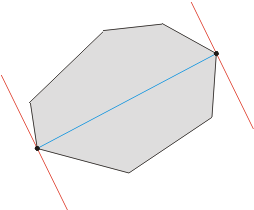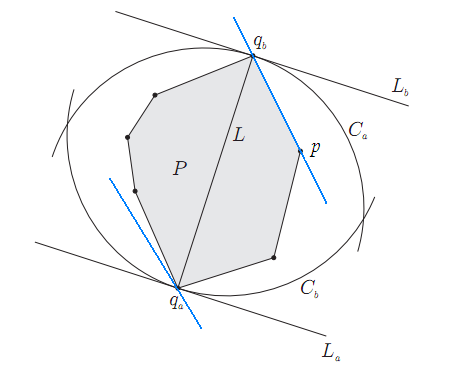拿凸包直径(也就是凸包上最远的两点的距离)为例,原始的算法是这样子:

- Compute the polygon's extreme points in the y direction. Call them ymin and ymax.
- Construct two horizontal lines of support through ymin and ymax. Since this is already an anti-podal pair, compute the distance, and keep as maximum.
- Rotate the lines until one is flush with an edge of the polygon.
- A new anti-podal pair is determined. Compute the new distance, compare to old maximum, and update if necessary.
- Repeat steps 3 and 4 until the anti-podal pair considered is (ymin,ymax) again.
- Output the pair(s) determining the maximum as the diameter pair(s).
更具体的可参见http://cgm.cs.mcgill.ca/~orm/rotcal.frame.html
直接按照这个描述可以实现旋转卡壳算法,但是代码肯定相当冗长。逆向思考,如果qa,qb是凸包上最远两点,必然可以分别过qa,qb画出一对平行线。通过旋转这对平行线,我们可以让它和凸包上的一条边重合,如图中蓝色直线,可以注意到,qa是凸包上离p和qb所在直线最远的点。于是我们的思路就是枚举凸包上的所有边,对每一条边找出凸包上离该边最远的顶点,计算这个顶点到该边两个端点的距离,并记录最大的值。直观上这是一个O(n2)的算法,和直接枚举任意两个顶点一样了。但是注意到当我们逆时针枚举边的时候,最远点的变化也是逆时针的,这样就可以不用从头计算最远点,而可以紧接着上一次的最远点继续计算(详细的证明可以参见上面链接中的论文)。于是我们得到了O(n)的算法。
 //计算凸包直径,输入凸包ch,顶点个数为n,按逆时针排列,输出直径的平方
//计算凸包直径,输入凸包ch,顶点个数为n,按逆时针排列,输出直径的平方 int rotating_calipers(Point *ch,int n)
int rotating_calipers(Point *ch,int n) {
{ int q=1,ans=0;
int q=1,ans=0; ch[n]=ch[0];
ch[n]=ch[0]; for(int p=0;p<n;p++)
for(int p=0;p<n;p++) {
{ while(cross(ch[p+1],ch[q+1],ch[p])>cross(ch[p+1],ch[q],ch[p]))
while(cross(ch[p+1],ch[q+1],ch[p])>cross(ch[p+1],ch[q],ch[p])) q=(q+1)%n;
q=(q+1)%n; ans=max(ans,max(dist2(ch[p],ch[q]),dist2(ch[p+1],ch[q+1])));
ans=max(ans,max(dist2(ch[p],ch[q]),dist2(ch[p+1],ch[q+1])));  }
} return ans;
return ans;  }
} 很难想象这个看起来那么麻烦的算法只有这么几行代码吧!其中cross函数是计算叉积,可以想成是计算三角形面积,因为凸包上距离一条边最远 的点和这条边的两个端点构成的三角形面积是最大的。之所以既要更新(ch[p],ch[q])又要更新(ch[p+1],ch[q+1])是为了处理凸包 上两条边平行的特殊情况。
poj2187要求的是平面点集上的最远点对,实际上就是该点集的凸包的直径。可能该题数据求得的凸包顶点数都不多,所以旋转卡壳算法相比普通的枚举算法并没有明显的优势。完整代码如下。
 #include <cmath>
#include <cmath> #include <algorithm>
#include <algorithm> #include <iostream>
#include <iostream> using namespace std;
using namespace std; #define MAXN 50005
#define MAXN 50005
 struct Point
struct Point {
{ int x, y;
int x, y; bool operator < (const Point& _P) const
bool operator < (const Point& _P) const {
{ return y<_P.y||(y==_P.y&&x<_P.x);
return y<_P.y||(y==_P.y&&x<_P.x); };
}; }pset[MAXN],ch[MAXN];
}pset[MAXN],ch[MAXN];
 void convex_hull(Point *p,Point *ch,int n,int &len)
void convex_hull(Point *p,Point *ch,int n,int &len) {
{ sort(p, p+n);
sort(p, p+n); ch[0]=p[0];
ch[0]=p[0]; ch[1]=p[1];
ch[1]=p[1]; int top=1;
int top=1; for(int i=2;i<n;i++)
for(int i=2;i<n;i++) {
{ while(top>0&&cross(ch[top],p[i],ch[top-1])<=0)
while(top>0&&cross(ch[top],p[i],ch[top-1])<=0) top--;
top--; ch[++top]=p[i];
ch[++top]=p[i]; }
} int tmp=top;
int tmp=top; for(int i=n-2;i>=0;i--)
for(int i=n-2;i>=0;i--) {
{ while(top>tmp&&cross(ch[top],p[i],ch[top-1])<=0)
while(top>tmp&&cross(ch[top],p[i],ch[top-1])<=0) top--;
top--; ch[++top]=p[i];
ch[++top]=p[i]; }
} len=top;
len=top;  }
}
 int cross(Point a,Point b,Point o)
int cross(Point a,Point b,Point o)  {
{ return (a.x - o.x) * (b.y - o.y) - (b.x - o.x) * (a.y - o.y);
return (a.x - o.x) * (b.y - o.y) - (b.x - o.x) * (a.y - o.y); }
}
 int dist2(Point a,Point b)
int dist2(Point a,Point b) {
{ return (a.x - b.x) * (a.x - b.x) + (a.y - b.y) * (a.y - b.y);
return (a.x - b.x) * (a.x - b.x) + (a.y - b.y) * (a.y - b.y); }
}
 int rotating_calipers(Point *ch,int n)
int rotating_calipers(Point *ch,int n) {
{ int q=1,ans=0;
int q=1,ans=0; ch[n]=ch[0];
ch[n]=ch[0]; for(int p=0;p<n;p++)
for(int p=0;p<n;p++) {
{ while(cross(ch[p+1],ch[q+1],ch[p])>cross(ch[p+1],ch[q],ch[p]))
while(cross(ch[p+1],ch[q+1],ch[p])>cross(ch[p+1],ch[q],ch[p])) q=(q+1)%n;
q=(q+1)%n; ans=max(ans,max(dist2(ch[p],ch[q]),dist2(ch[p+1],ch[q+1])));
ans=max(ans,max(dist2(ch[p],ch[q]),dist2(ch[p+1],ch[q+1])));  }
} return ans;
return ans;  }
}
 int main()
int main() {
{ //freopen("in.txt","r",stdin);
//freopen("in.txt","r",stdin); int n, len;
int n, len; while(scanf("%d", &n)!=EOF)
while(scanf("%d", &n)!=EOF) {
{ for(int i = 0;i < n;i++)
for(int i = 0;i < n;i++) {
{ scanf("%d %d",&pset[i].x,&pset[i].y);
scanf("%d %d",&pset[i].x,&pset[i].y); }
} convex_hull(pset,ch,n,len);
convex_hull(pset,ch,n,len); printf("%d\n",rotating_calipers(ch,len));
printf("%d\n",rotating_calipers(ch,len)); }
} return 0;
return 0; }
}
poj3608 要 求的是两个凸包的最近距离。这比求凸包直径麻烦了许多。我的基本思想还是分别枚举两个凸包的边,但是有些细节没能完全证明是正确的。虽然AC了,但目前这 还只是一个看起来正确的算法。这题的中间过程还需要计算点到线段的距离和两条平行线段的距离,比起2187麻烦了许多。
 #include <iostream>
#include <iostream> #include <algorithm>
#include <algorithm> #include <cmath>
#include <cmath> using namespace std;
using namespace std; #define MAXN 50000
#define MAXN 50000 #define EPS 1e-9
#define EPS 1e-9 struct Point
struct Point {
{ double x,y;
double x,y; Point (){}
Point (){} Point (double _x,double _y){x=_x;y=_y;}
Point (double _x,double _y){x=_x;y=_y;} }pm[MAXN],pn[MAXN];
}pm[MAXN],pn[MAXN];
 double cross(Point a,Point b,Point o)
double cross(Point a,Point b,Point o) {
{ return (o.x-a.x)*(o.y-b.y)-(o.x-b.x)*(o.y-a.y);
return (o.x-a.x)*(o.y-b.y)-(o.x-b.x)*(o.y-a.y); }
}
 double dist(Point a,Point b)
double dist(Point a,Point b) {
{ return (a.x-b.x)*(a.x-b.x)+(a.y-b.y)*(a.y-b.y);
return (a.x-b.x)*(a.x-b.x)+(a.y-b.y)*(a.y-b.y); }
}
 double dot(Point a,Point b)
double dot(Point a,Point b) {
{ return a.x*b.x+a.y*b.y;
return a.x*b.x+a.y*b.y; }
}
 void anticolockwise(Point *ch,int len)
void anticolockwise(Point *ch,int len) {
{ for(int i=0;i<len-2;i++)
for(int i=0;i<len-2;i++) {
{ double tmp=cross(ch[i],ch[i+1],ch[i+2]);
double tmp=cross(ch[i],ch[i+1],ch[i+2]); if(tmp>EPS)
if(tmp>EPS) return;
return; else if(tmp<-EPS)
else if(tmp<-EPS) {
{ reverse(ch,ch+len);
reverse(ch,ch+len); return;
return; }
} }
} }
}
 double dis_point_to_seg(Point c,Point a,Point b)
double dis_point_to_seg(Point c,Point a,Point b) {
{ Point ab=Point(b.x-a.x,b.y-a.y);
Point ab=Point(b.x-a.x,b.y-a.y); Point ac=Point(c.x-a.x,c.y-a.y);
Point ac=Point(c.x-a.x,c.y-a.y); double f=dot(ab,ac);
double f=dot(ab,ac); if(f<0) return dist(a,c);
if(f<0) return dist(a,c); double D=dot(ab,ab);
double D=dot(ab,ab); if(f>D) return dist(b,c);
if(f>D) return dist(b,c); f=f/D;
f=f/D; Point d=Point(a.x+f*ab.x,a.y+f*ab.y);
Point d=Point(a.x+f*ab.x,a.y+f*ab.y); return dist(d,c);
return dist(d,c); }
}
 double dis_pall_seg(Point p1, Point p2, Point p3, Point p4)
double dis_pall_seg(Point p1, Point p2, Point p3, Point p4) {
{ return min(min(dis_point_to_seg(p1, p3, p4), dis_point_to_seg(p2, p3, p4)),
return min(min(dis_point_to_seg(p1, p3, p4), dis_point_to_seg(p2, p3, p4)), min(dis_point_to_seg(p3, p1, p2), dis_point_to_seg(p4, p1, p2)));
min(dis_point_to_seg(p3, p1, p2), dis_point_to_seg(p4, p1, p2))); }
}
 double rc(Point *ch1,Point *ch2,int n,int m)
double rc(Point *ch1,Point *ch2,int n,int m) {
{ int q=0;
int q=0; int p=0;
int p=0; for(int i=0;i<n;i++)
for(int i=0;i<n;i++)  if(ch1[i].y-ch1[p].y<-EPS)
if(ch1[i].y-ch1[p].y<-EPS) p=i;
p=i; for(int i=0;i<m;i++)
for(int i=0;i<m;i++) if(ch2[i].y-ch2[q].y>EPS)
if(ch2[i].y-ch2[q].y>EPS) q=i;
q=i; ch1[n]=ch1[0];
ch1[n]=ch1[0]; ch2[m]=ch2[0];
ch2[m]=ch2[0]; double tmp,ans=1e99;
double tmp,ans=1e99; for(int i=0;i<n;i++)
for(int i=0;i<n;i++) {
{ while((tmp=cross( ch1[p+1],ch2[q+1],ch1[p]) - cross(ch1[p+1],ch2[q],ch1[p]) )>EPS)
while((tmp=cross( ch1[p+1],ch2[q+1],ch1[p]) - cross(ch1[p+1],ch2[q],ch1[p]) )>EPS) q=(q+1)%m;
q=(q+1)%m; if(tmp<-EPS)
if(tmp<-EPS) ans=min(ans,dis_point_to_seg(ch2[q],ch1[p],ch1[p+1]));
ans=min(ans,dis_point_to_seg(ch2[q],ch1[p],ch1[p+1])); else
else ans=min(ans,dis_pall_seg(ch1[p],ch1[p+1],ch2[q],ch2[q+1]));
ans=min(ans,dis_pall_seg(ch1[p],ch1[p+1],ch2[q],ch2[q+1])); p=(p+1)%n;
p=(p+1)%n; }
} return ans;
return ans;
 }
}
 int main()
int main() {
{ //freopen("in.txt","r",stdin);
//freopen("in.txt","r",stdin); int n,m;
int n,m; while(scanf("%d %d",&n,&m))
while(scanf("%d %d",&n,&m)) {
{ if(n==0&&m==0)
if(n==0&&m==0) break;
break; for(int i=0;i<n;i++)
for(int i=0;i<n;i++) scanf("%lf %lf",&pn[i].x,&pn[i].y);
scanf("%lf %lf",&pn[i].x,&pn[i].y); for(int i=0;i<m;i++)
for(int i=0;i<m;i++) scanf("%lf %lf",&pm[i].x,&pm[i].y);
scanf("%lf %lf",&pm[i].x,&pm[i].y); anticolockwise(pn,n);
anticolockwise(pn,n); anticolockwise(pm,m);
anticolockwise(pm,m); printf("%.5f\n",sqrt(min(rc(pn,pm,n,m),rc(pm,pn,m,n))));
printf("%.5f\n",sqrt(min(rc(pn,pm,n,m),rc(pm,pn,m,n)))); }
} return 0;
return 0; }
}
